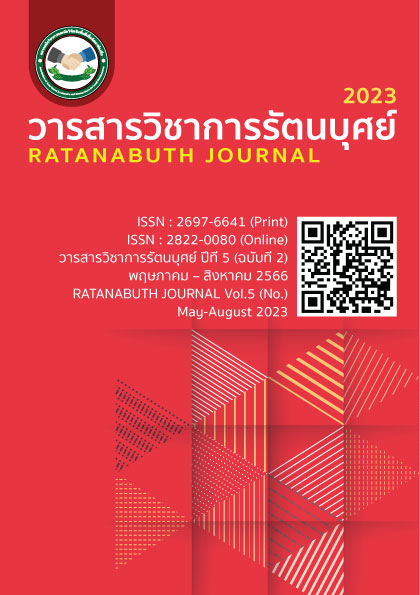Creative Leadership Based on Yonisomanasikara of School Administrators Creative Leadership Based on Yonisomanasikara of School Administrators
Main Article Content
Abstract
This article aims to study the creative leadership according to the Yonisomasikara principal of school administrators. The study found that the creative leadership of school administrators is the leader who exhibits creative behavior and thinks thoroughly in various situations. and issues There is a process to solve problems in the current situation in a correct way. There is a process to solve problems that are clear and correct. Be a leader who is constantly learning, constantly evolving, and has a positive attitude towards the world and towards life. Believe in the worth and potential of yourself and others. have creative ideas Know how to use the crisis as an opportunity to manage people, manage money, and resources available at educational institutions. by relying on both external and internal factors to support each other The most important thing is to have good friends with colleagues. Or that is an external factor that will help strengthen the faith to happen in the right way. and to think in the right way by using methodical thinking based on wisdom and cover all relevant dimensions to develop right view that will lead people to behave in performing their duties by the principle of “Yonisomanasikara”, a thinking technique that is useful for educational institute administration. Able to use in thinking, planning in school administration, work, solving problems, helping in making decisions, analyzing, and following up on work plans. Emphasizing on 4 main concepts: thinking using various methods (Planning) right thinking to get to the truth, thinking in an orderly way. It is an episode in order of cause and effect. no confusion (Prima sikha), cause-and-effect thinking Find cause-and-effect relationships that result in a chain of consequences (Manikara) and goal-oriented thinking. Set results in advance to encourage yourself to accomplish your goals (Upadakamonasikarn).
Article Details

This work is licensed under a Creative Commons Attribution-NonCommercial-NoDerivatives 4.0 International License.
References
กรองทิพย์ นาควิเชตร. (2562). ภาวะผู้นำสร้างสรรค์เพื่อการศึกษา. สมุทรปราการ: สำนักพิมพ์ธีรสาร์นพับลิวเซอร์.
กวี วงศ์พุฒ. (2559). ภาวะผู้นำ. พิมพ์ครั้งที่ 2. กรุงเทพฯ: ศูนย์ส่งเสริมวิชาชีพบัญชีกรุงเทพ.
กิตติ์กาญจน์ ปฏิพันธ์. (2564). ภาวะผู้นำเชิงสร้างสรรค์: Creative Leadership. สืบค้นเมื่อ 14 มิถุนายน 2566. จาก http://www.academia.edu/8634471/Creative_Leadership.
จินดารัตน์ โพธิ์นอก. (2564). ภาวะผู้นำเชิงสร้างสรรค์. สืบค้นเมื่อ 14 มิถุนายน 2566. จากhttps://www.academia.edu/8634471/CreativeLeadership_ภาวะผู้นำเชิงสร้างสรรค์.
เนตร์พัณณา ยาวิราช. (2556). ภาวะผู้นำและผู้นำเชิงกลยุทธ์. พิมพ์ครั้งที่ 8. กรุงเทพฯ: ทริปเพิ้ลกรุ๊ป.
บุญทัน ดอกไธสง. (2558). การจัดการองค์การ. กรุงเทพฯ: มหาจุฬาลงกรณราชวิทยาลัย.
ปกรณ์ วงศ์รัตนพิบูลย์. (2564). ภาวะผู้นำ. สืบค้นเมื่อ 12 มิถุนายน 2566. จาก http://www. entraining.net/article06_leadership.php.
ปทุม เปียถนอม. (2561). ภาวะผู้นำเต็มรูปแบบ:ปัจจัยสำคัญในการบริหารโรงเรียนประชารัฐ.วิทยานิพนธ์การศึกษามหาบัณฑิต สาขาวิชาการบริหารการศึกษา. กรุงเทพฯ: จุฬาลงกรณ์มหาวิทยาลัย.
ประเวศ วะสี. (2555). ภาวะผู้นำและความเป็นไปในสังคมไทยและวิธีการแก้ไข. กรุงเทพฯ: ธนวัชการพิมพ์.
พระครูวิจิตรปัญญาภรณ์ (2565). ภาวะผู้นําาเชิงพุทธในองค์การทางการศึกษาในยุคดิจิทัล. วารสารบัณฑิตสาเกตปริทรรศน์. 7(1), 37-45.
พระครูสุนทรปริยัติกิจ. (2560). กระบวนการโยนิโสมนสิการกับภาวะผู้นาการเปลี่ยนแปลง ของนายกเทศมนตรีในเขตพื้นที่ภาคตะวันออก. วารสารวิชาการมหาวิทยาลัยปทุมธานี. 9(2). 156.
พระธรรมปิฎก (ป.อ. ปยุตฺโต). (2538). พุทธธรรม ฉบับปรับปรุงและขยายความ. พิมพ์ครั้งที่ 6. กรุงเทพฯ: โรงพิมพ์มหาจุฬาลงกรณราชวิทยาลัย.
พระธรรมปิฎก (ป.อ. ปยุตฺโต). (2546). พุทธธรรม. กรุงเทพฯ: โรงพิมพ์มหาจุฬาลงกรณราชวิทยาลัย.
ไพฑูรย์ สินลารัตน์. (2561). ความเป็นผู้นำทางการศึกษา. กรุงเทพฯ: สำนักพิมพ์แห่งจุฬาลงกรณ์มหาวิทยาลัย.
มนวิภา พวงลำเจียก, สมศักดิ์ บุญปู่,ระวิง เรืองสังข์และอิษยา สาธรสันติกุล.(2562).รูปแบบการพัฒนาภาวะผู้นำทางความคิดสร้างสรรค์ ตามหลักโยนิโสมนสิการสำหรับผู้บริหารสถานศึกษาปฐมวัย สังกัดองค์กรปกครองส่วนท้องถิ่น. วารสารมหาจุฬานาครทรรศน์. 6(6), 2988-3006.
มหามกุฏราชวิทยาลัย. (2525). พระไตรปิฎกภาษาบาลี ฉบับสฺยามรฏฺฐเตปิฏกํ 2525. กรุงเทพฯ: โรงพิมพ์มหามกุฏราชวิทยาลัย.
สำนักงานเลขาธิการสภาการศึกษา. (2560). แนวทางการพัฒนาการศึกษาไทยกับการเตรียมความพร้อมสู่ศตวรรษที่ 21. กรุงเทพฯ: สำนักงานเลขาธิการสภาการศึกษา.
Basadur, M. (2008). Leading other to think innovatively together: Creative leadership. Journal of The Leadership Quarterly. 15(1), 103-121.
Bass, B. M. (1990). Bass & Stogdill's handbook of leadership: Theory, research, and managerial applications. 3rd ed. American: Free Press.
Halpin, A.W. (2006). Theory and research in administration. New York: Macmillan.
Harris (2009). Creative Leadership: Developing Future Leaders. Management in Education. 23(1), 9-11.
Hersey&Blanchard (2009). Management of Organizational Behavior. 7th ed. New Jersey: Prentice-Hall, Inc.
Ruth Ash and Persall. (2007). The principal as Chief Learning Officer: Developing Teacher Leaders. NASSP Bulletin. 84(616), 15-22.
Zuberbühler, K., Cheney, D. L., & Seyfarth, R. M. (1999). Conceptual Semantics in a Nonhuman Primate. Journal of Comparative Psychology. 113(1), 33–42.


